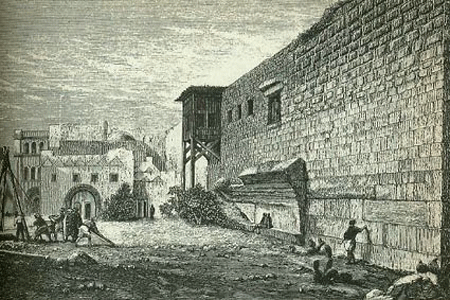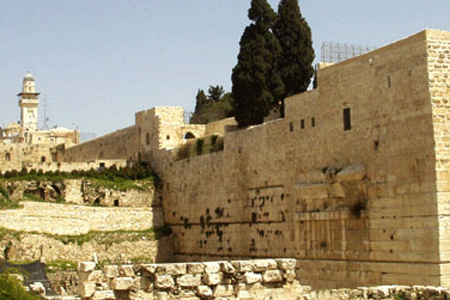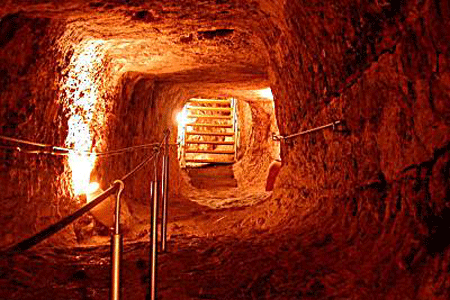|
|
|
 |
|
"IT WAS IN THE HEART OF
DAVID, MY FATHER,
TO BUILD A TEMPLE FOR THE NAME OF THE LORD, THE GOD OF ISRAEL"
I KINGS 8:17
|
|
|
 |
|
 |
|
 |
| |
It all
started on a hot summer’s day in 1865. British
Baroness Angela Burdett Coutts, on a pilgrimage to
the holy city, was thirsty. When Mahmoud, her
guide, drew up a bucket of stinking water from a
courtyard cistern, Coutts thought to herself, would
Jesus have drunk such smelly water? And what
about King David?
When she returned to England, Coutts donated 500
pounds sterling to help establish the Palestine
Exploration Fund. She convinced her friend and
neighbor Vicky to be a sponsor of the new
organization. (Vicky, by the way, was none
other than Queen Victoria.) The goal of the
P.E.F. was to promote research into the archaeology
and history, manners and customs, culture,
topography, geology and natural sciences of biblical
Palestine and the Near East.
|
|
 |
|
Illustration in the
Land and the Book by W. M. Thomson, published
1869 |
|
Dome of the Rock on the Temple
Mount at the time of Charles Warren |
| |
Two
years later, the P.E.F. sent 27-year-old Lieutenant
(later Captain) Charles Warren of the British Royal
Engineering Corps to Jerusalem. His
instructions were to investigate the site of the
Temple, the line of fortifications, the City of
David, and the authenticity of the traditional
Church of the Holy Sepulcher. Warren had
previously made a name for himself by perilously
scaling and charting the Rock of Gibraltar.
In February 1867, Warren, a buddy from the Gibraltar
climb named Corporal Henry Birtles, (promoted to
sergeant during the course of the expedition), two
other corporals, a photographer, a surveyor and 8
mule-loads of equipment including crowbars, ropes,
jacks, handspikes, blocks and wheels, arrived in
Jerusalem. |
| |
At the
time, the Ottoman Turks ruled the holy land and holy
city. As the firman (permit) to dig had
not yet arrived from Constantinople, Warren insisted
that the British consul arrange a meeting for him
with the pasha, the Turkish ruler of Jerusalem.
To the consul’s surprise, Warren convinced the pasha
to approve digging around (but not inside) the Haram
es-Sharif, the Noble Sanctuary, known to us as the
Temple Mount. A Moslem ruler would not allow
an excavation inside the Haram, third holiest site
to Islam, containing the Dome of the Rock and the Al
Aqsa Mosque.
|
|
 |
Warren, however, was
not deterred. He hired local diggers and at a
distance from the outer walls of the Temple Mount,
he dug a number of shafts and then began to tunnel
towards the Temple area. The people of
Jerusalem noted he was always underground and
nicknamed him “The Mole.”
At one point, the curious pasha wanted to see what
was going on underground, and demanded to be let
down the shaft. The pasha was slowly lowered
on a board attached to two ropes and just before he
reached the tunnel leading towards the Temple Mount,
expedition members holding the ropes began to yank
them. The frightened pasha shrieked and begged
to be pulled up above ground. Wiping the sweat
off his forehead, the pasha congratulated Warren on
his bravery. |
|
Wilson and Warren,
The Recovery of Jerusalem |
|
| Warren
works by light of a candle in one of the underground
shafts, 1869 |
| |
|
When the firman finally arrived from
Constantinople, Warren was startled to read
that the
expedition was permitted to dig everywhere, except
for Christian and Moslem religious sites.
Well, that was exactly where he intended to
excavate. Warren decided to wave the firman
around and say “I got it,” but be sure to show it to
no one. |
| |
For the
next few months, he and his team sank shafts around
the Temple Mount, digging down through more than 130
feet of rubble to reach bedrock. The task was
difficult and dangerous, as the mountain of debris
above their heads tended to shift. They had a
procession of “lucky escapes,” when falling stones
nearly crushed them
to death.
One nineteenth century British historian wrote, “It
was Warren who stripped the rubbish from the rocks
and showed the glorious temple standing within its
walls 1,000 feet long and 200 feet high, of mighty
masonry. It was he who laid open the valleys
now covered up and hidden; he who opened the secret
passages, the ancient aqueducts, the bridge
connecting the temple and the town.” (Warren,
in fact, found not the walls of the temple, but the
outer retaining walls of the temple platform.) |
| |
|
 |
|
Wilson and Warren,
The Recovery of Jerusalem |
|
Warren’s excavations near
Robinson’s Arch 1867-1870 |
| |
|
 |
|
Photo: Gila Yudkin |
|
Robinson’s Arch and the southwest
corner of the Temple Mount, 2005 |
| |
| Warren’s
greatest contribution was his suggestion that
Jerusalem D.C. (David’s Capital) lay outside the
medieval walls of the Old City. At that time,
everyone believed that the “Old City” was the old
city, meaning fortifications from the days of David
were located somewhere below the present city walls.
However, at the bottom of one of Warren’s shafts
outside the south-eastern corner of the Temple
Mount, Warren found the remains of a massive city
wall that was leading southwards, away from the
walls of the Old City. |
| |
As
Warren tunneled alongside this wall for some 700
feet, he noted that it went way beyond the limits of
the city. The wall itself later proved to be
fifth century AD, but the possibility, never before
considered, arose that the earlier city could have
been located south of the Temple Mount and the city
walls, close to the city’s source of water, the
Gihon Spring.
At the end of October 1867, Warren and his team
explored a man-made conduit, leading
away from the Gihon Spring. Warren recorded in
his journal that in the beginning it was easy
walking until they reached 600 feet into the tunnel.
Then they began crawling on all fours. As they
saw bits of cabbage-stalks floating by, they
realized that the waters had started to rise.
Warren described himself with a pencil, compass and
field book in his hands, and the candle for the most
part in his mouth. He and Birtles had just 4
inches breathing space. When observing, his
mouth was under water.
|
At 900
feet into the tunnel, they discovered false turns
and began to go in a zigzag direction. It was
here that Warren inadvertently swallowed part of his
lead pencil, nearly choking. When they came
out shivering, it was dark. They had been
nearly four hours in the water.
(Today, the 1750 foot walk through
Hezekiah’s Tunnel is a LOT more fun.
It takes us some 40 minutes – and the water is only
knee-high!)
|
| |
Where the
tunnel began at the spring, Warren noticed
that the water first collected in an
underground, cave-like chamber. With
the help of his team and local Arab workers,
Warren cleaned out the cave and found the
entrance to a tunnel. He followed it
for 40 feet, where it ended in a curious
shaft which rose into the darkness above his
head. A few days later, Warren and
Birtles returned to climb the shaft.
|
“By jamming
the boards against the side of the shaft, we
succeeded in getting up 20 feet,” reported
Warren in a letter. “On lighting a
piece of magnesium wire, we could see 20
feet above us, a piece of loose masonry
impending directly over our heads and as
several loose pieces had been found at the
bottom, it occurred to both of us that our
position was critical. Without
speaking of it, we eyed each other ominously
and wished we were a little higher up.”
The intrepid Royal Engineers kept climbing
to find another tunnel at the top of the
shaft and a series of caves leading up
towards a blocked entrance. Slowly, it
dawned on Warren that he had unearthed a
hidden water system leading to the spring
from somewhere on the southeastern ridge.
This, coupled with the ancient wall and the
tunnel leading to the Pool of Siloam, had
striking implications. It meant that there
had definitely been a settlement outside the
medieval walls of the city.
Controversy raged for another hundred years
until the implications of Charles Warren’s
discovery became accepted by all. This
was in the 1960s, when Kathleen Kenyon, also
digging under the auspices of the P.E.F.,
revealed the 18th century BC city wall. The
“oldest” city of Jerusalem was indeed
located outside the “old city” walls, on the
southeast ridge, close to the source of
water.
The “water system” discovered by Warren,
today called “Warren’s Shaft” in his memory,
seems to be a natural karstic limestone
sinkhole and not man-made, as it was thought
for over a hundred years. Excavations
in the area, pioneered by Warren, are
ongoing and the last word remains to be
said.
|
|
 |
|
Underground passageway
called Warren's Shaft |
| |
| Although
Warren could not excavate within the Haram
compound itself, his good relations with the
guards enabled him to make a thorough
examination of the structure of the Dome of
the Rock and the network of cisterns within
the area. He counted some 34 rock-hewn
reservoirs of different shapes and sizes,
the largest of them 43 feet deep with a
capacity of over two million gallons.
As far as we know, Charles Warren was the
first and last to survey beneath the
Temple
Mount. |
| |
Tour the Temple
Mount in the
company of Abraham and Isaac, David and Solomon,
Jesus and the disciples, the angel Gabriel and
Mohammed -- and Gila. Meet many other luminaries,
both real and legendary.
Gila's Temple Mount tour
is now available as a written
24-page PDF with a
Temple Mount plan,
guidelines for passing the security check
and ten recommended reads on the
Temple Mount from Gila's bookshelves.
|
| Here’s an excerpt of Warren’s account of
digging in the blocked up Huldah Gates which
he calls the Double Passage in Underground
Jerusalem, published in 1876, |
| |
“While Sergeant Birtles and I cut our
way through the strong walls of the Double
Passage, [one of the most sacred of the
Moslem praying places, being the presumed
site of Solomon’s Palace,] our faithful
Moslem friends kept guard inside and
outside and diverted the attention of
those who wanted to come there to pray.
In the sanctuary live, for the protection
of the place, certain Africans or Nubian
men, of the most bigoted nature, who think
nothing of life or the loss of it; to
these the good keeping of the sanctuary is
left, and their fanaticism knows no
bounds, but I found means to be friendly
with these people.
They once ate a very large pet lizard of
mine which I wanted to send home to the
Zoological Gardens in London, and I took
advantage of the occurrence to make
friends with them, so that instead of
coming and throwing stones at me when I
entered the Temple area by myself, they
would stand up and deferentially salaam.
However, I never attempted to test their
good feeling too far, and on this occasion
they were given a hint that they might
obtain a smell of grilled lizard if they
went in a certain direction. This
was enough for them, they are greedily
fond of the large lizard, which happens to
be my namesake, Warren, and were thus out
of our way.
The blows of our hammers resounded in the
vaults and soon our Moslem friends got
into the greatest fright lest all would be
discovered: however, we were in for it; if
we were to be set upon and eaten up
instead of the lizard, we might as well
complete our work first.
Accordingly, whenever we were implored to
stop, we made the more noise until our
friends lay in a corner tearing their
beards and plucking at their garments in
the greatest state of agonized terror.
It was very exciting; we had visions of
wonderful vaults beyond us with sculpture
and what not, but, when we had got through
the wall, we only found earth against it
with rough face, or rather no face.
There are certainly no vaults to the east
of the Standing place of Elias…
And so we had put our lives in the
greatest peril for these negative
results….As soon as we had done the work,
we got our tools out of the passage in the
same secret manner we had brought them in,
and appeared under the clear winter sky –
two very grubby-looking mortals, for we
had been groping head foremost in the
earth. We could not go outside in
such a state, and measures were taken to
clean us up a little. It was very
exciting, for by this time our Nubian
friends had found that in the hunt after
the lizard they were on a false scent, and
that the lizard (Warren) they should have
been after was in the double tunnel, and
came back to find out what was going on;
but we had completed our work and were not
to be torn in pieces on this occasion."
|
Charles
Warren dug in Jerusalem for only three
years. In 1870 a new firman
arrived from Constantinople forbidding all
excavation. Warren packed his bags and
returned to England at the age of 30. He
died in 1927 at the age of 86. He had
an illustrious career which included walking
from the Indian to the Atlantic Ocean,
marking out the border between South Africa
and Zimbabwe and walking from the Atlantic
to the Pacific Ocean, marking out the border
between Canada and the U.S. There is a
Warren, Michigan and a Warren Minnesota, to
celebrate this feat. His last job was
Commissioner of the London Police. At
one point Sherlock Holmes asks Dr. Watson,
“Should we ask Commissioner Warren?”
However, as Commissioner, he did not succeed
in catching Jack the Ripper.
On tour in Jerusalem, we tell colorful tales
of Captain Charles Warren before we splash
through Hezekiah’s Tunnel, as we descend
Warren’s Shaft and when we visit the Western
Wall Tunnel’s “Masonic Hall’ discovered and
named by Charles Warren who was a Freemason. |
| |
|
Copyright 2006,
2010
Gila Yudkin. Permission needed for any reuse. |
| |
Coming to Jerusalem
soon?
Would you like to find the venues
where you can
quietly be transported back in your imagination to
the time of Jesus? David? Abraham?
Make every minute matter while you "Explore
Jerusalem's Soul" with
Gila's Unorthodox Guide.
This up-to-date PDF (Adobe Acrobat) 46-page guide
gives you the Top Ten places to meditate on the
Bible, the Top Ten lesser-known churches worth
visiting, the Top Ten most rewarding roof-top
views and the top Ten places for Middle Eastern
food. More on
Gila's Jerusalem Guide....
|
| More
Holy Land explorers |
|
|
|
"Ten
Tips for a Terrific Temple Mount Tour"
suggests how to reap the maximum inspiration during your
visit to the Temple Mount. |
|
|
|
GILA
YUDKIN
•
TCHERNIKOVSKI
64A
•
JERUSALEM
•
ISRAEL
gila@itsgila.com
HOME
•
BOOK
GILA
•
TIPS
FOR TOURS •
ABOUT GILA
|
|

